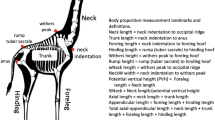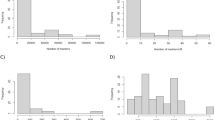Abstract
Both male-male competition and female choice are important forces in sexual selection that may act in concert. In red deer (Cervus elaphus), rutting activities related to male-male competition are highly conspicuous and have received most research attention. However, there is increasing evidence that females can gain by selecting mates. Due to the additive genetic benefits of a sire’s dominance rank, females may prefer them as mates, so that selection for male traits associated with dominance can be reinforced by female choice. On the other hand, recent evidence suggests that females might prefer male features not related to dominance and thus affect the distribution of mating outcomes. This predicts mating with less dominant males, but no study has so far investigated to which extent some females may do so when the dominant male is available. Here we use controlled captivity conditions to study whether females mate with subordinate males when dominant males are present. By means of parentage analyses conducted after genoty** the offspring, we found that dominant males did not sire all the offspring, the mean percentage of offspring sired by subordinate males being 13.03%. This result has consequences for the evolutionary reinforcement of components of sexual selection in red deer and might be used as a starting point for future studies on the red deer mating system and sexual selection.

Similar content being viewed by others
References
Amos W, Worthington Wilmer J, Fullard K, Burg TM, Croxall JP, Bloch D, Coulson T (2001) The influence of parental relatedness on reproductive success. Proc R Soc Lond Ser B 268:2021–2027
Anderson M (1994) Sexual selection. Princeton University Press, Princeton, NJ
Carling MD, Wiseman PA, Byers JA (2003) Microsatellite analysis reveals multiple paternity in a population of wild pronghorn antelopes (Antilocapra americana). J Mamm 84:1237–1243
Carranza J (1995) Female attraction by males versus sites in territorial rutting red deer. Anim Behav 50:445–453
Carranza J, Valencia J (1999) Red deer females collect on male clumps at mating areas. Behav Ecol 10:525–532
Carranza J, Alvarez F, Redondo T (1990) Territoriality as a mating strategy in red deer. Anim Behav 50:445–453
Carranza J, Pérez-González J, Mateos C, Fernández-García JL (2009) Parents’ genetic dissimilarity and offspring sex in a polygynous mammal. Mol Ecol 18:4964–4973
Carranza J, Salinas M, de Andrés D, Pérez-González J (2016) Iberian red deer: paraphyletic nature at mtDNA but nuclear markers support its genetic identity. Ecol Evol 6:905–922
Charlton BD, Reby D, McComb K (2007) Female red deer prefer the roars of larger males. Biol Lett 3:382–385
Chesser RK (1991) Influence of gene flow and breeding tactics on gene diversity within populations. Genetics 129:437–447
Clutton-Brock TH, Guinness FE, Albon SD (1982) Red deer: behavior and ecology of two sexes. Edinburg University Press, Edinburg, United Kingdom
Clutton-Brock TH, Albon SD, Guinness FE (1988) Reproductive success in male and female red deer. In: Clutton-Brock TH (ed) reproductive success. University of Chicago Press, Studies of Individual Variation in Contrasting Breeding Systems. Chicago, pp 325–343
Clutton-Brock T, McAuliffe K (2009) Female mate choice in mammals. Q Rev Biol 84:3–27
Coltman DW, Pilkington JG, Smith JA, Pemberton JM (1999) Parasite-mediated selection against inbred Soay sheep in a free living, island population. Evolution 53:1259–1267
Darwin C (1871) The descent of man, and selection in relation to sex. Appleton, New York
Delgado-Acevedo J, Zamorano A, DeYung RW, Campbell TA, Hewitt DG, Long DB (2011) Promiscuous mating in feral pigs (Sus scrofa). Wildlife Res 37:539–546
DeYoung RW, Demarais S, Gonzales RA, Honeycutt RL, Gee KL (2002) Multiple paternity in white-tailed deer (Odocoileus virginianus) revealed by DNA microsatellites. J Mamm 83:884–892
Ditchkoff SS, Lochmiller RL, Masters RE, Hoofer SR, Van Den Bussche RA (2001) Major-histocompatibility-complex-associated variation in secondary sexual traits of white-tailed deer (Odocoileus virginianus): evidence for good-genes advertisement. Evolution 55:616–625
Double MC, Cockburn A (2003) Subordinate superb fairy-wrens (Malurus cyaneus) parasitize the reproductive success of attractive dominant males. Proc R Soc Lond Ser B 270:379–384
Emlen DJ (2008) The evolution of animal weapons. Ann Rev Ecol Evol Syst 39:387–413
Foerster K, Coulson T, Sheldon BC, Pemberton JM, Clutton-Brock TH, Kruuk LEB (2007) Sexually antagonistic genetic variation for fitness in red deer. Nature 447:1107–1110
Guinnes FE, Lincoln GA, Short RV (1971) The reproductive cycle of the female red deer. J Reprod Fert 27:427–428
Hunt J, Breuker CJ, Sadowski JA, Moore AJ (2009) Male–male competition, female mate choice and their interaction: determining total sexual selection. J Evol Biol 22:13–26
Jennings DJ, Hayden TJ, Gammell MP (2013) Personality and predictability in fallow deer fighting behaviour: the relationship with mating success. Anim Behav 86:1041–1047
Jennions MD, Petrie M (2000) Why do females mate multiply? A review of the genetic benefits. Biol Rev 75:21–64
Jones OR, Wang J (2010) COLONY: a program for parentage and sibship inference from multilocus genotype data. Mol Ecol Resour 10:551–555
Kotiaho JS, LeBas NR, Puurtinen M, Tomkins JL (2008) On the resolution of the lek paradox. Trends Ecol Evol 23:1–3
Kruuk LEB, Slate J, Pemberton JM, Brotherstone S, Guinness FE, Clutton-Brock TH (2002) Antler size in red deer: heritability and selection but no evolution. Evolution 56:1683–1695
Malo AF, Roldan ERS, Garde J, Soler AJ, Gomendio M (2005) Antlers honestly advertise sperm production and quality. Proc R Soc Lond Ser B 272:149–157
Martín J, Carranza J, López P, Alarcos S, Pérez-González J (2014) A new sexual signal in rutting male red deer: age related chemical scent constituents in the belly black spot. Mamm Biol 79:362–368
Mays HL, Hill GE (2004) Choosing mates: good genes versus genes that are a good fit. Trends Ecol Evol 19:554–559
Millar SA, Dykes DD, Polesky HF (1988) A simple salting out procedure for extracting DNA from human nucleated cells. Nucleic Acid Res 16:1215
Pemberton JM, Albon SD, Dover LE (1992) Behavioural estimates of male mating success tested by DNA fingerprinting in a polygynous mammal. Behav Ecol 3:66–75
Pérez-González J, Carranza J (2009) Female-biased dispersal under conditions of low male mating competition in a polygynous mammal. Mol Ecol 18:4617–4630
Pérez-González J, Barbosa AM, Carranza J, Torres-Porras J (2010) Relative effect of food supplementation and natural resources on female red deer distribution in a Mediterranean ecosystem. J Wildl Manag 74:1701–1708
Pérez-González J, Costa V, Santos P, Slate J, Carranza J, Fernández-Llario P, Zsolnai A, Monteiro NM, Anton I, Buzgó J, Varga G, Beja-Pereira A (2014) Males and females contribute unequally to offspring genetic diversity in the polygynandrous mating system of wild boar. PLoS One 9:e115394
Shuster SM (2009) Sexual selection and mating systems. Proc Natl Acad Sci U S A 106:10009–10016
Stopher KV, Nussey DH, Clutton-Brock TH, Guinness F, Morris A, Pemberton JM (2011) The red deer rut revisited: female excursions but no evidence females move to mate with preferred males. Behav Ecol 22:808–818
Stopher KV, Nussey DH, Clutton-Brock TH, Guinness F, Morris A, Pemberton JM (2012) Re-mating across years and intralineage polygyny are associated with greater than expected levels of inbreeding in wild red deer. J Evol Biol 25:2457–2469
Suttie JM (1979) The effect of antler removal on dominance and fighting behaviour in farmed red deer stags. J Zool 190:217–224
Trivers RL (1972) Parental investment and sexual selection. In: Campbell B (ed) Sexual selection and the descent of man. Aldine, Chicago, pp 136–179
Vanpé C, Gaillard J-M, Kjellander P, Mysterud A, Magnien P, Delorme D, Van Laere G, Klein F, Liberg O, Hewison AJM (2007) Antler size provides an honest signal of male phenotypic quality in roe deer. Am Nat 169:481–493
Van Oosterhout C, Hutchinson WF, Wills DPM, Shipley P (2004) Micro-checker: software for identifying and correcting genoty** errors in microsatellite data. Mol Ecol Notes 4:535–538
Wade MJ, Shuster SM (2004) Sexual selection: harem size and the variance in male reproductive success. Am Nat 164:83–89
Wiley RH, Poston J (1996) Indirect mate choice, competition for mates, and coevolution of the sexes. Evolution 50:1371–1381
Wong BBM, Candolin U (2005) How is female mate choice affected by male competition? Biol Rev 80:559–571
Acknowledgements
We thank Sophie Mowles and two anonymous reviewers for comments to the manuscript. Jose Manuel Seoane and Sheila Martín helped in field work and sample collection. Carmen Marín Arjona contributed with laboratory work. Ignacio Enrile and Manuel Reglero provided permissions and facilitates for field work and sampling.
Funding
This work was funded by projects CGL2013-48122-P and CGL2016-77052-P from the Spanish Ministry of Science.
Author information
Authors and Affiliations
Corresponding author
Ethics declarations
Conflict of interest
The authors declare that they have no conflict of interest.
Ethical approval
This study never provoked additional hurt or stress to the animals. All applicable international, national and institutional guidelines for the care and use of animals were followed.
Additional information
Publisher’s note
Springer Nature remains neutral with regard to jurisdictional claims in published maps and institutional affiliations.
Electronic supplementary material
ESM 1
(PDF 634 kb)
Rights and permissions
About this article
Cite this article
Pérez-González, J., Carranza, J. Offspring sired by subordinate red deer males under controlled conditions: did some females prefer not to mate with the alpha male?. acta ethol 23, 31–37 (2020). https://doi.org/10.1007/s10211-020-00336-9
Received:
Revised:
Accepted:
Published:
Issue Date:
DOI: https://doi.org/10.1007/s10211-020-00336-9




